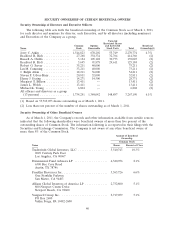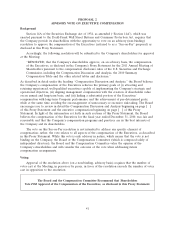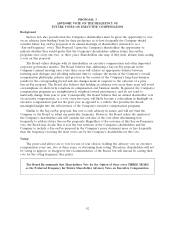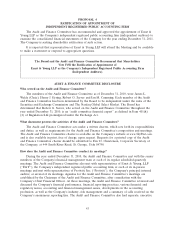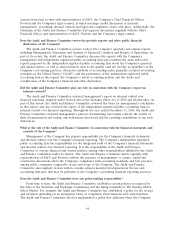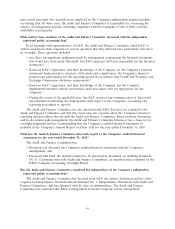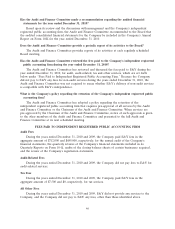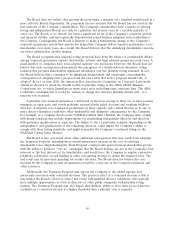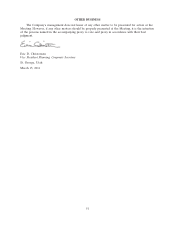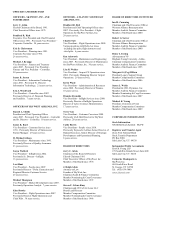SkyWest Airlines 2010 Annual Report Download - page 171
Download and view the complete annual report
Please find page 171 of the 2010 SkyWest Airlines annual report below. You can navigate through the pages in the report by either clicking on the pages listed below, or by using the keyword search tool below to find specific information within the annual report.The Board does not believe that electing directors under a majority vote standard would result in a
more effective Board. Importantly, the proponent has not asserted that the Board has not acted in the
best interests of the Company’s shareholders. The Company’s shareholders have a history of electing
strong and independent Boards, not only by a plurality, but in most cases by a sizeable majority of
votes cast. The Board, as so elected, has been a significant factor in the Company’s consistent growth
and financial stability, and has repeatedly demonstrated sound business judgment in its leadership of
the Company. Consequently, the Board is hesitant to make a fundamental change to the Company’s
corporate governance system that already has helped the Company deliver superior performance to its
shareholders over many years. As a result, the Board believes that the underlying shareholder concerns
are better addressed in another manner.
The Board recognizes that majority voting proposals have been the subject of considerable debate
among corporate governance experts, shareholder activists and legal advisory groups in recent years. A
small number of companies have even adopted majority vote provisions. However, the Board does not
believe that such circumstances demonstrate the emergence of a widely-selected alternative voting
standard that provides shareholders significant advantages over the plurality voting standard. In fact,
the Board believes there continues to be significant disagreement and uncertainty concerning the
consequences of adopting such a proposal and the exact form that such a proposal should take, if
adopted. In fact, in June 2006, the American Bar Association’s Committee on Corporate Laws made
official its decision to retain the default system of plurality voting in the ABA’s Model Business
Corporation Act, to which lawmakers in many states refer in drafting state corporate laws. The ABA
Committee concluded that it would be ‘‘unwise to change the statutory plurality default rule’’ to a
majority vote standard.
A plurality vote standard guarantees a full board of directors as long as there are at least as many
nominees as open seats, and avoids problems associated with failed elections and resulting holdover
directors. A majority vote standard is problematic in these regards, and a failed election as to one or
more director nominees could have other undesirable and disruptive consequences for the Company.
For example, as a company listed on the NASDAQ Global Select Market, the Company must comply
with listing standards that include requirements for maintaining independent directors and directors
with particular qualifications or expertise. The failure to elect a particular nominee, depending on the
independence and qualifications of the remaining directors, could impair the Company’s ability to
comply with those listing standards, and might jeopardize the Company’s continued listing on the
NASDAQ Global Select Market.
The Board is also concerned about other additional consequences that may result from adopting
the Teamsters Proposal, including the potential unnecessary increase in the cost of soliciting
shareholder votes. Implementing the Team Proposal could provide special interest shareholder groups
with the ability to promote ‘‘vote-no’’ campaigns that the Board believes are not in the Company’s best
interests or the best interests of its shareholders, and would force the Company to employ a proactive
telephone solicitation, second mailing or other vote-getting strategy to obtain the required votes. The
end result may be increased spending for routine elections. The Board does not believe the costs
incurred by the Company in such circumstances would be a wise use of the Company’s financial and
other resources.
Additionally, the Teamsters Proposal may expose the Company to the added expense and
uncertainty associated with contested elections. The practical effect of a contested election is that it
may hinder the Board’s efforts to attract and retain well-qualified director candidates, who typically
have multiple opportunities to serve as directors of other public companies with plurality voting
systems. The Teamsters Proposal may also impair shareholders’ ability to elect their favored director
candidate in a contested election if a higher threshold than a plurality vote is required.
49



